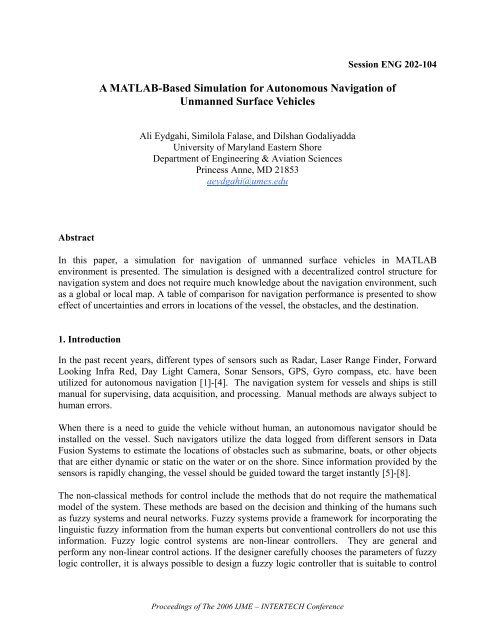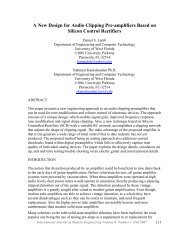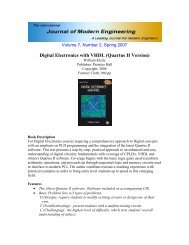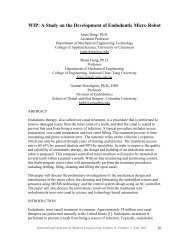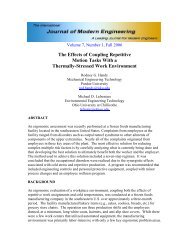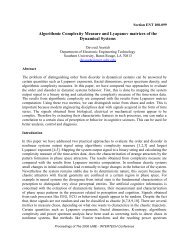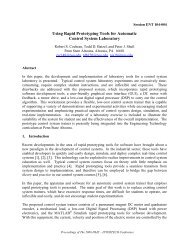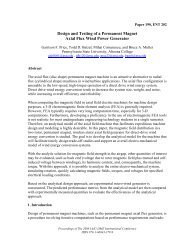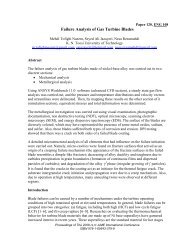A MATLAB-Based Simulation for Autonomous Navigation of ... - IJME
A MATLAB-Based Simulation for Autonomous Navigation of ... - IJME
A MATLAB-Based Simulation for Autonomous Navigation of ... - IJME
You also want an ePaper? Increase the reach of your titles
YUMPU automatically turns print PDFs into web optimized ePapers that Google loves.
1. MFX 1 – This M-file controls the ship’s diversion in path. It comprises <strong>of</strong> the fuzzy logicalgorithm <strong>for</strong> the “evalmf’ function. This is the control system that provides the logicnecessary <strong>for</strong> the vessel to deviate from its path to the M-file Ship.m.2. ALFAX – This M-file calculates the angle, α, in radians as well as the X and Ycoordinates required to calculate α. This angle, α, is the angle in the vector triangle madeby the vectors between position and target <strong>for</strong> both X and Y coordinates.3. SHIP – Taking into consideration the logic provided by MFX1 M-file and the rudderangle calculated by ALFAX, this M-file determines the next position <strong>of</strong> the ship. Thismeans that the rudder angle ‘alfa’ (α), and the position vector (X, Y) are considered toget the next position (X1,Y1). The SHIP M-file is shown in figure 4.Figure 4: SHIP M-file4. SELECT_PATH – This is the M-file <strong>for</strong> the user to decipher between the two kinds <strong>of</strong>obstacles available.5. PATH2, PATH4 – These are the main M-files that contain the user interface and theplotting functions. These files also calculate the time elapsed within the journey fromOrigin to Target. The PATH2 M-file contains a different variety <strong>of</strong> <strong>for</strong>mations <strong>of</strong>obstacles from which the user can select one. With PATH4 file, the user is able to choosethe number <strong>of</strong> obstacles and their locations on the grid. The user interface from PATH4file is shown in Figure 5.Proceedings <strong>of</strong> The 2006 <strong>IJME</strong> – INTERTECH Conference
Figure 5: User Interface6. TARGETX – This M-file computes the values <strong>for</strong> ‘out,’ and ‘mf’ required <strong>for</strong> the PATH4M-file that helps to calculate the location <strong>of</strong> the next coordinate.7. OBSX – This M-file generates the non-lethal static obstacle such as a rock. Because <strong>of</strong>the non-lethal nature <strong>of</strong> it, diversion angle is set at Π/2 so that it merely avoids clashing.8. OBSX1- This M-file generates a lethal static obstacle such as an enemy ship. Thediversion angle is set to 3Π to grant the ship a greater divergence.3.1. OperationFirst the user has to enter “SELECT_PATH” on the command window. Then, out <strong>of</strong> the twoavailable paths one should be selected. One <strong>of</strong> the paths provides the user with an option <strong>of</strong>selecting the number <strong>of</strong> individual obstacles positioned based on the user’s input, and the other iswhere the user can choose a <strong>for</strong>mation <strong>of</strong> obstacles which can be related to a configuration basedon a predefined or expected occurrence <strong>of</strong> obstacles such as a cluster <strong>of</strong> icebergs or rocks. Theoptions comprise <strong>of</strong> simple geometric arrangements in the predefined X-Y plane - a perfectProceedings <strong>of</strong> The 2006 <strong>IJME</strong> – INTERTECH Conference
square, a parallelogram shifted to the right or the left, a straight diagonal line, and a trapezoidwith the parallel lines parallel to the X-axis or parallel to the Y-axis.When the user selects the first path, the starting X and Y coordinates <strong>of</strong> the ship are requestedthrough the interface. The position <strong>of</strong> the destination, in <strong>for</strong>m <strong>of</strong> coordinates, is also requested.Next, the interface requests a total number <strong>of</strong> obstacles the user wishes to place, with a choice <strong>of</strong>one to three. The user is then able to pick the appropriate type <strong>of</strong> obstacles, either lethal or nonlethal.For each obstacle the user is also allowed to enter the position <strong>of</strong> each <strong>of</strong> the obstacles.When the user selects the second path, the program as in the other path will ask <strong>for</strong> the user toinput the starting and ending points as well as the desired velocity <strong>of</strong> the vehicle. However, nowthe user’s choice is between the six different obstacle configurations as explained above.3.2. OutputsFor the first path there are three plots as the output. The first plot shows the displacement <strong>of</strong> theship. This figure also displays the non-lethal obstacles in green color and lethal obstacles in redcolor. On the other hand, the second plot displays the Y coordinate with time in addition to thevelocity-time graphs. The final plot shows the rudder activity versus time graph. The first plot isshown in figure 6. Figure 7 shows another output <strong>for</strong> this path although this time it is <strong>for</strong> twoobstacles.Figure 6: The Displacement <strong>of</strong> the VehicleProceedings <strong>of</strong> The 2006 <strong>IJME</strong> – INTERTECH Conference
Figure 7: Output <strong>for</strong> Two ObstaclesFor the output <strong>of</strong> the second path, there is one plot. This shows the obstacle <strong>for</strong>mation as well asthe path which is taken to reach the target. Figure 8 shows the output <strong>for</strong> one <strong>of</strong> the <strong>for</strong>mations.Figure 8: Output <strong>of</strong> One <strong>of</strong> the Obstacle ConfigurationsProceedings <strong>of</strong> The 2006 <strong>IJME</strong> – INTERTECH Conference
Figure 9 shows a case when a matrix <strong>of</strong> lethal obstacles is implemented. As shown, this resultedin vessel not reaching the target after all ef<strong>for</strong>ts it made to avoid the obstacles.Figure 9: Output <strong>of</strong> a Lethal Obstacle ConfigurationAnother key output provided by this s<strong>of</strong>tware is the time the vessel takes to go from the origin toits target position. To determine the effect <strong>of</strong> the obstacle variations towards the elapsed time, weconsidered different number <strong>of</strong> obstacles placed between the same origin and target at differentplaces. Table 1 represents the data collected from this experiment.Table 1: Time Elapsed <strong>for</strong> Different Formations <strong>of</strong> ObstaclesNumber <strong>of</strong>obstaclesPosition <strong>of</strong> firstobstaclePosition <strong>of</strong> SecondobstaclePosition <strong>of</strong> thirdobstacleTime3 (4,4) - non lethal (6,6) - lethal (8,8) - lethal 2062 (2,4) - non lethal (5,5) - non lethal non 2083 (4,4) - lethal (6,6) - non lethal (9,9) - non lethal 213non lethal placed as a parallelogram in intervals <strong>of</strong> 1 both in theX and Y directions 350Square<strong>for</strong>mationSquare<strong>for</strong>mationlethal placed as a parallelogram in intervals <strong>of</strong> 1 both in the Xand Y directions401 – be<strong>for</strong>edrowningProceedings <strong>of</strong> The 2006 <strong>IJME</strong> – INTERTECH Conference
4. ConclusionThe development <strong>of</strong> a <strong>MATLAB</strong>-based simulation <strong>for</strong> navigation <strong>of</strong> an unmanned surfacevehicle has been presented. The program is able to take into consideration the occurrence <strong>of</strong>obstacles along the path <strong>of</strong> travel. The successful generation and simulation <strong>of</strong> two differentkinds <strong>of</strong> static obstacles, one a lethal obstacle and the other, a non-lethal obstacle are presented.The program has been developed in such a way that it can be easily incorporated into otherrelated applications <strong>for</strong> unmanned navigation designs.5. References[1] K.Y. Pettersen and T.I. Fossen, “Underactuated Dynamic Positioning <strong>of</strong> Ship-Experimentalresults,” IEEE Transactions on Control Systems technology, September 2000, pp. 856-863.[2] K.Y. Petterson and O. Egeland, “Exponential Stabilization <strong>of</strong> an Underactuated SurfaceVessel,” Proc. 35 th IEEE Conf. on Decision and Control, December 1996. pp 967-970.[3] N.E. Leonard, “Periodic Forcing, Dynamics and Control <strong>of</strong> Underactuated spacecraft andUnderwater Vehicles,” Proc. 34 th IEEE Conference on Decision and Control, Dec. 1995, pp.3980- 3985.[4] Hussein, A S. “Numerical <strong>Simulation</strong> <strong>of</strong> Neural Network-Controlled Unmanned UnderseaVehicle.” WSEAS Transactions on Circuits and Systems. Vol. 2, no. 3, pp. 608-615. July2003.[5] A. Meystel, “Planning in a Hierarchical Nested <strong>Autonomous</strong> Control System,” SPIEConference on Mobile Robots. Eds. W. J. Wolfe and N. Marquina. Cambridge, MA, pp. 42-76. 1987.[6] P. Enge, T. Walter, S. Pullen, C. Kee, C., Y.C. Chao, and Y.J. Tsai, “Wide AreaAugmentation <strong>of</strong> the Global Positioning System,” Proceedings <strong>of</strong> the IEEE, Volume 84, No.8, August 1996.[7] B. Moshiri, A. Eydgahi, M. Najafi, and R.H. Nezhad, “Multi-Sensor Data Fusion Used inIntelligent <strong>Autonomous</strong> <strong>Navigation</strong>,” Proceedings <strong>of</strong> IASTED International Conference onControl and Applications, Banff, Canada, July 25-29, pp. 515-520, 1999.[8] L. Alparone, F. Argenti, G. Benelli, V. Cappellini, and A. Mecocci, “A Fuzzy CompleteSAR Processing Chain <strong>for</strong> Ship Detection and Velocity Estimation,” European Trans.Telecommunications Relations Technology, Vol. 2, No. 6, 1991, pp. 689-694.[9] L.A. Zadeh, “Outline <strong>of</strong> a New Approach to the Analysis <strong>of</strong> Complex Systems and DecisionProcesses,” IEEE Trans. on Systems, Man, and Cybernetics, 1973, pp. 28-44.[10] E.H. Mamdani, “Application <strong>of</strong> Fuzzy Logic to Approximate Reasoning Using LinguisticSynthesis,” IEEE Transactions on Computers,1977, pp.1182-1191.[11] A.M. Eydgahi, and M. Fotouhi, “A Fuzzy Knowledge-<strong>Based</strong> Controller to Tune PIDParameters,” Computers in Education Journal, Vol. 10, No 2, pp. 2-7, April/June, 2000.[12] H. Beigy and A.M. Eydgahi, “An Adaptive Fuzzy Model Reference Control <strong>for</strong> RobotManipulators,”Proceedings <strong>of</strong> International Conference on Automation, Indore, India,December 12-14, pp. 59-62, 1995.Proceedings <strong>of</strong> The 2006 <strong>IJME</strong> – INTERTECH Conference
[13] H. Beigy, A.M. Eydgahi, and S.D. Katebi, “Elastic Fuzzy Logic <strong>for</strong> Self-Learning ControlSystems,” Proceedings <strong>of</strong> 1995 IEEE International Conference on Neural Networks,Perth, Western Australia, 27 November - 1 December, pp. 622-626, 1995.[14] M. Jamshidi, R. Marchbanks, K. Bisset, R. Kelsey, S. Baugh, and D. Barak, Computer-Aided Design <strong>of</strong> Fuzzy Control Systems: S<strong>of</strong>tware and Hardware Implementations, ElsevierScience publishers, pp. 81-89, 1992.[15]Y.G. Zhang, J. Xiang, and J. Xiao, J. “Design <strong>of</strong> Decentralized PDC Controllers <strong>for</strong>Discrete-Time Fuzzy Large-Scale Systems: An LMI Method,” Control and Decision, Vol.19, No. 3, 2004, pp. 351-354.[16] S.C. Tong and T.Y. Chai, “Direct Adaptive Fuzzy Output Feedback Control <strong>for</strong> UncertainNonlinear Systems,” Control and Decision, Vol. 19, No. 3, 2004, pp. 257-261.[17] F. McNeill, Fuzzy Logic: A Practical Approach, Academic Press Limited, 1994.[18] Mathworks Inc., Fuzzy Logic Toolbox,www.mathworks.comBiographiesALI EYDGAHI is a Pr<strong>of</strong>essor and Chair <strong>of</strong> Engineering and Aviation Sciences Department at University <strong>of</strong>Maryland Eastern Shore. He is recipient <strong>of</strong> the Dow Outstanding Young Faculty Award from American Society <strong>for</strong>Engineering Education in 1990, and the Silver Medal <strong>for</strong> outstanding contribution from International Conference onAutomation in 1995. Dr. Eydgahi has served as a session chair and a member <strong>of</strong> scientific and internationalcommittees <strong>for</strong> many international conferences and has published more than hundred papers in refereedinternational and national journals and conference proceedings.SIMILOLA FALASE is an undergraduate student in Electrical Engineering program at the University <strong>of</strong> MarylandEastern Shore. Her research interest is to design intelligent systems <strong>for</strong> control industry.DISHAN GODALIYADDA is a senior student in Electrical Engineering program at the University <strong>of</strong> Maryland.His current research interest is in the area <strong>of</strong> data visualization and simulation.Proceedings <strong>of</strong> The 2006 <strong>IJME</strong> – INTERTECH Conference


